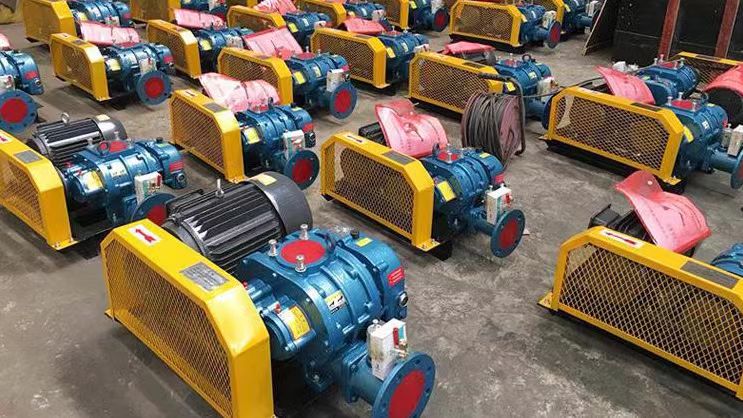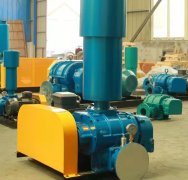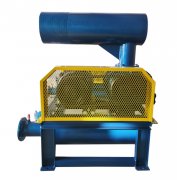65 Roots blower is a small positive displacement fan with the characteristics of compact structure, stable air volume, and moderate pressure boosting ability. The following analysis is conducted from the aspects of performance parameters, structural characteristics, application scenarios, selection and maintenance:
1、 Performance parameters
Wind volume range: Common models have a wind volume between 0.76-3.65m3/min. For example, the -65 model has a wind volume of 0.76m3/min at a pressure of 9.8kPa and 3.65m3/min at a pressure of 78.4kPa, which can meet the needs of small and medium-sized pneumatic conveying, aeration and oxygenation scenarios.
Pressure range: The pressure boosting capacity is usually 9.8-78.4kPa, suitable for low to medium pressure conditions, such as aeration in small sewage treatment plants, laboratory gas supply, etc.
Motor power: The standard motor power is 0.75-7.5kW, and energy consumption can be further optimized through variable frequency speed regulation, such as reducing operating costs in intermittent aeration scenarios.
Structural Features
Three bladed rotor design: Adopting a spiral three bladed rotor, a progressive compression chamber is formed during operation to reduce airflow pulsation. The noise is reduced by 5-10 decibels compared to a two bladed rotor, and the vibration amplitude is reduced by more than 30.
Precision synchronous gear: The gear pair is treated with carburizing and quenching, with an accuracy of ISO level 6, ensuring that the rotor synchronization error is ≤ 0.02mm, and can maintain a clearance accuracy of 0.1-0.2mm even after long-term operation.
Oil free lubrication structure: using a combination of labyrinth seal and skeleton oil seal to prevent lubricating oil from penetrating into the air chamber, suitable for industries such as medicine and food that require high gas cleanliness.
Modular design: The intake and exhaust ports support various installation methods such as horizontal, vertical, and lateral, and accessories such as mufflers, filters, and valves can be quickly integrated to shorten the engineering debugging cycle.
3、 Application scenarios
Wastewater treatment: Used for aeration tanks in small wastewater treatment plants, a single fan can meet the dissolved oxygen demand of 50-200m3/d treatment scale, and with the help of a dissolved oxygen meter to achieve PID frequency conversion control, the energy saving rate can reach 20-30%.
Aquaculture: A small-scale circular aquaculture system suitable for family farms or research bases, which achieves dissolved oxygen levels of ≥ 6mg/L and increases aquaculture density by more than 30% through nano microporous aeration discs.
Laboratory equipment: provides a stable gas source for gas chromatographs, fermentation tanks, etc., with pressure fluctuations of ≤± 1 and flow accuracy better than ± 2, meeting the requirements of precision experiments.
Material conveying: capable of conveying powder materials with a particle size of ≤ 1mm and a conveying distance of ≤ 50m, suitable for measuring and conveying clean materials such as food additives and pharmaceutical raw materials.
4、 Key selection points
Flow verification: Pipeline resistance loss needs to be considered, and it is recommended to reserve a flow margin of 10-15. For example, when used in high-altitude areas, the air volume parameters need to be adjusted according to atmospheric pressure.
Pressure matching: The actual operating pressure should be lower than 80% of the rated pressure. For example, when the system back pressure reaches 60kPa, a model with a rated pressure of 78.4kPa should be selected.
Material selection: When transporting corrosive gases, it is recommended to use 304/316L stainless steel material for the rotor, and coat the inner wall of the casing with PTFE coating to improve corrosion resistance by 2-3 orders of magnitude.
Drive mode: Priority should be given to using variable frequency motor drive, combined with PLC to achieve 0-50Hz stepless speed regulation, with a response time of ≤ 0.2s, to meet the dynamic adjustment requirements of process parameters.
5、 Maintenance and upkeep
Daily inspection: Check the bearing temperature (≤ 85 ℃), vibration value (≤ 4.5mm/s), oil level (at 1/2-2/3 of the sight glass) daily, and record the motor current (80- of the rated current).
Regular maintenance: Replace the lubricating oil of the gearbox every 2000 hours of operation, check the rotor clearance every 5000 hours, and conduct a whole machine balance test every 10000 hours to ensure that the residual unbalance is ≤ 0.5g · mm/kg.
Fault handling: Establish standardized processing procedures for common problems such as bearing overheating (lubrication system needs to be checked), insufficient flow (intake filter needs to be cleaned), abnormal noise (gear meshing status needs to be checked), etc., with an average repair time (MTTR) of ≤ 4 hours.



